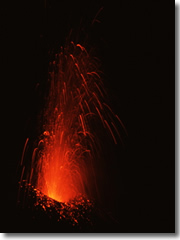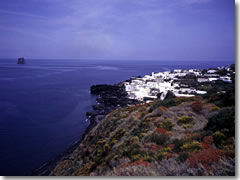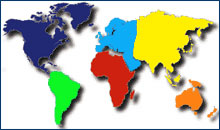A night atop the volcano
Climbing Stromboli, a violently active volcano and the last in the line of Aeolian Islands off the coast of Sicily
 The mountain had been rumbling all day, but it wasn't until the setting sun sent sparking streamers across the azure Tyrrhenian Sea surrounding us that Stromboli's fireworks truly began.
The mountain had been rumbling all day, but it wasn't until the setting sun sent sparking streamers across the azure Tyrrhenian Sea surrounding us that Stromboli's fireworks truly began.
With a primal roar and a boom that shook the entire island, the smaller of the cones inside the crater below us exploded in fire, spewing tons of molten lava hundreds of feet into the air. Jay and I were too dumbstruck even to grope for our cameras.
As the red glow faded and the magma spattered back to earth like fat raindrops, I turned to my friend and we could both think of only one reaction: "Wow."
Pyrotechnics over for at least the next 20 minutes or so, I looked around the rim of the ancient crater. We stood on the lip of a large bowl, in the bottom of which snuggled Stromboli's trio of active cones gurgling, hissing, steaming, and growling in between eruptions.
At regular intervals along the rim were foot-high curved walls of stacked pumice stone--some just a wind-blocking curl, others spiraled like a seashell. "Well," I said, gesturing to the walls. "Let's pick out a shelter for the night."
Up the Volcano

The town of Stromboli, seen from the start of the hike up the mountainStromboli is the most active volcano in Europe and looks every inch the part: a perfect cone of a mountain jutting 3,055 feet from the sea, with smoke trailing from its summit and some 400 hardy souls living in whitewashed cube homes barnacled along the shoreline.
Two to five times every hour, this "lighthouse of the Mediterranean" erupts explosively, sending a tight conical spray of superheated gases, lava, and ash shooting anywhere from 400 to 1,500 feet into the air at speeds up to 400 feet per second.
In daylight you can't see the glow of lava--it just looks like a spray of mud. Against the night sky, however, the fireworks can be spectacular. Officially, you can't climb Stromboli without a guide, but the rule is rarely enforced, and guided groups spend only a few hours at the summit, coming down at sunset.
Jay and I wanted to spend whole the night up there.
We dropped off our bags at the hotel where we'd be staying the following night, crammed into our daypacks two liters of water, some snacks, a tent ground cloth, flashlights, and ponchos, and furtively snuck out of town—illegally and without a guide—to follow the red-and-white blazes along the mule path that twisted through the Spanish broom, African fodder cane, thistle, and maidenstears and slowly wound its way up the mountain.
The hike was a strenuous four hours under the brutal summer Sicilian sun. We'd gone through three-quarters of our water before we even reached the top, and I'd slipped and barked my shin nastily against some rocks.
But the climb was worth it. We sat for hours atop the ground cloth behind the little wall of rocks we'd picked out, waiting for this Italian Old Faithful to put on yet another show. Eventually, after a dozen explosions or so, exhaustion edged out the excitement and I lay down to get some sleep.
I had forgotten about Aeolius.
God of the Winds

The volcano of Stromboli glows at dawnTo the ancient Greeks, the Aeolians Islands chain was home to Aeolius, the God of the Winds, who stored his stock in the caves riddling the islands. His weren’t just any old breezes. They were winds of myth and legend, the very gusts that knocked Odysseus off course and left him sailing in circles around the Mediterranean for a decade.
More importantly, they skimmed uninterruptedly across the surface of Stromboli in a ground-hugging torrent, a sheet of stiff breezes that rarely rose more than six inches off the ground. I'd barely noticed them...until I lay down my head.
Our little protective wall proved woefully inadequate. This wind whipped around the ground like a snake, coming at us from any angle it could and carrying with it a trillion microscopic particles of pumice, forcing the hard dust into my ears, mouth, nostrils, and—when I was dumb enough to open them—my eyes. Eventually I hit upon the bright idea of spinning my poncho around backward to pull the hood over my face, and managed to catch a catnap.
Then the rain started.
It was a downpour and its was on us sudden. We yanked the tiny ground cloth from under us to huddle beneath it, and spent the rest of the night in misery.
Our legs stuck out and got soaked, it got so cold my teeth chattered, and streamlets of water ran through the ground layer of dust and trickled down the back of my neck. Every once in a while, we'd hear the volcano roar to life again, mocking us in our foolishness.
The Volcano Aftermath
Just before dawn, the rain stopped. We threw off the tarp, grabbed our soggy daypacks and started blearily and miserably stumbling back down the mountain, our waterlogged shoes squishing with every step.
No amount of scrubbing in the hotel room sink could get the pumice out of our jeans. I left mine stuffed in the hotel trashcan; J bravely soldiered on through a few more wash cycles before abandoning his. By the time we hit Palermo a few days later, Jay's sniffles had developed into full-blown sinusitis and we ended up spending a lovely day at the Palermo Civic Hospital. My skinned shin got infected and festered, and my camera, gummed up with pumice dust, never worked right again. I had to chuck it by the time I got home.
We'd spent a fantastic night atop the volcano, witnessed a sight we'd remember for the rest of our days, and learned a valuable lesson. You cannot gird yourself with a measly tarp and poncho, flout the rules to invade the house of a god, and expect to come away unscathed.
When You Go...
Most ferries and faster hydrofoils serving the Aeolians leave from Milazzo on Sicily's northeastern shore. There are also several a day from Messina (where ferries from Reggio di Calabria on the Italian mainland land) and from Naples (summertime hydrofoils from Naples take four hours, but more evocative are the year-round overnight ferries, taking eight hours and arriving at Stromboli just in time to watch sunrise over the volcano).
Across the road from the black sands of Ficogrande beach lie two good hotels. Kindly Giuseppe Guadagna runs Pensione La Nassa, a very clean, laughably cheap little hotel 65 feet from the beach off the main seaside road leading from the port. Cool sea breezes sweep the tile floors of the relatively spacious, ground-floor accommodations, whose private little patios have sea views. The baths are brand new, furnishings in good shape, and beds firmer than my own back home. Book early before the backpackers get all the rooms. They also rent small apartments by the week. Loc. Ficogrande, Stromboli, Isole Eolie. tel. +39-090-986-033 or +39-339-239-9585 (in winter call tel. +39-090-928-1271). www.lanassastromboli.it. No credit cards. Closed Oct-Easter. €–€€
La Nassa is a great budget gem, but to splash out, head to La Sirenetta Park Hotel, near the end of the road along Ficogrande beach, with a couple of good restaurants, a terraced pool with sea view, diving school and sailing lessons, it's own Greek-style theater, and terrific sea views from the modestly confy Mediterranean rooms. It's closed Nov to May. Via Marina 33, Stromboli, Isole Eolie. tel. +39-090-986-025. www.lasirenetta.it. €€€–€€€€
In the middle of the village, La Trottola (Via Roma 32-34 (on the main road, just up from the port). tel. +39-090-986-046) serves cheap but excellent pennette alla strombolana (pasta quills with tomatoes, olives, capers, and tuna) and decent pizza.
Related Articles |
Outside Resources |
This article was last updated in August 2010. All information was accurate at the time.
Copyright © 1998–2010 by Reid Bramblett. Author: Reid Bramblett.



 ShareThis
ShareThis

